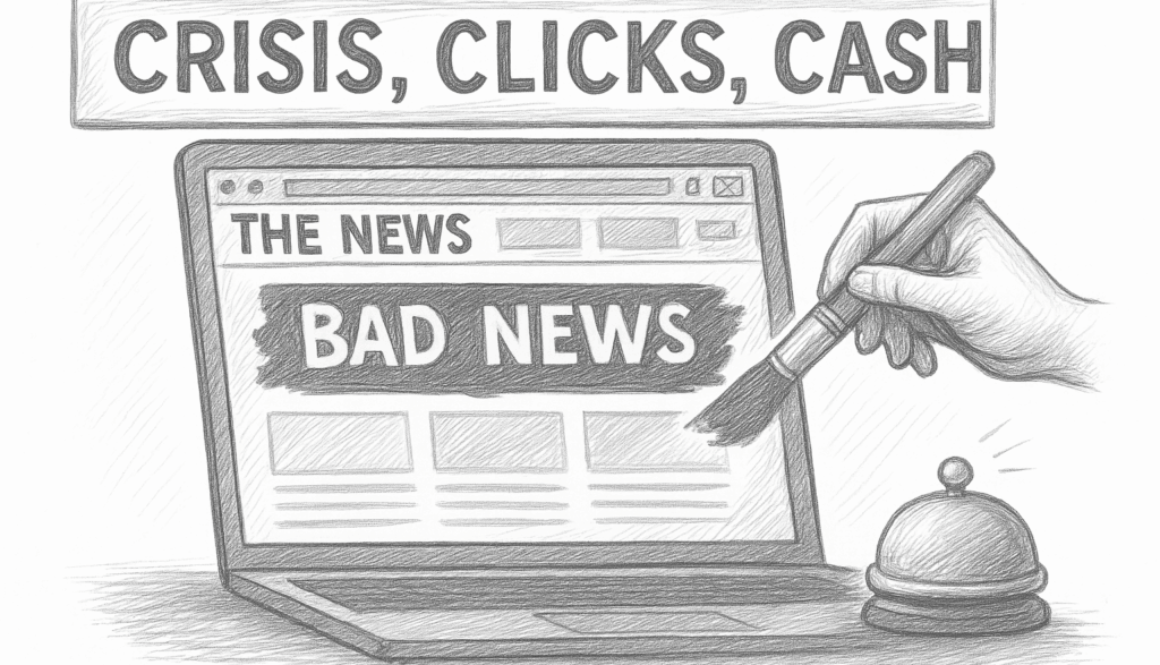Crisis, Clicks, Cash
Bad news isn’t an accident. It’s an economy.
Hey doomscrollers—
Your brain isn’t broken.
It’s doing exactly what it evolved to do: fixating on threats. Sabertooth tiger? Deadly drought? Rival tribe? Pay attention or get eaten. Fast-forward a few millennia, and the saber-tooth is gone, but the bias stayed.
Which is why in 2025 your feed looks like a war zone of recessions, scandals, and disasters—even when GDP is up and you just got a raise.
Why we can’t quit doom
Multiple studies keep showing the same ugly truth: negative news headlines get 30–40% more clicksthan neutral or positive ones. A 2023 analysis of 100k articles confirmed over half of headlines were negatively framed.
Algorithms optimize for engagement, so negativity wins the auction every time. The cycle is self-perpetuating: outrage boosts clicks, clicks boost ad revenue, revenue tells editors to turn the crank harder.
And no, it’s not because “the world is worse.” By most metrics—poverty rates, disease, even wars—the world is less deadly than 50 years ago.
But perception beats reality every single time.

Fear makes markets twitch
Markets are jittery not because investors read reports but because they read headlines.
- COVID, 2020: $11 trillion wiped in weeks before the virus had even spread globally. The panic was the product.
- Recession hype, 2022–23: NBER research showed pessimistic coverage accelerates downturns. Businesses pull back “just in case,” and guess what? That caution creates the slowdown.
- Inflation panic, 2024: consumer spending dipped in Europe despite real wages rising, purely because news cycles screamed “crisis.” People didn’t feel richer, so they didn’t spend.
Markets don’t run on fundamentals alone. They run on mood—and mood runs on headlines.
Brands built on fear
Insurance, pharma, cybersecurity—some of the most profitable industries today owe their dominance to the ability to weaponize anxiety. They don’t just sell products; they sell protection from nightmares, both real and imagined. Cybersecurity spending will hit $188B in 2025, not because hacks have suddenly tripled, but because fear-based campaigns convince CEOs that not buying protection is corporate suicide. Big Pharma plays the same card with “what if the next pandemic is worse?” Insurance thrives on the whispered what if that keeps you awake at 3am.
But here’s the dirty secret:fear is an accelerant, not a foundation.
It spikes sales in the short term but erodes trust in the long run. Remember the COVID gougers? They made headlines, then made enemies. Contrast that with Patagonia or Moderna’s repositioning: Patagonia doesn’t scream apocalypse—it frames climate crisis as a call to arms. Moderna shifted from doomsday scenarios to a message of stability and readiness.
Fear is easy. Hope, positioned well, outlasts it.
Breaking the doom loop
Negativity bias isn’t going anywhere—you can’t debug evolution. But businesses can decide whether to exploit it shamelessly or to play smarter.
Too many brands binge on panic marketing like it’s an energy drink—cheap, spiky, and ultimately leaving the audience with a crash and a headache.
The smarter alternative? Frame risk as solvable.
Saying “AI will kill your job” gets clicks, but pairing it with tools and training builds customers. Balance fear with agency. Outrage might get you viral, but agency earns you loyalty. And above all, play the long game.Fear may open wallets, but trust keeps them open.
Panic is fast food. Credibility is compound interest.
The choice is simple: you can keep feeding the doom loop, or you can break it by giving people a story they actually want to stick with.
Then…
Negativity is the cheapest currency in media. It sells ads, it moves markets, it hijacks strategy. But if your business only reacts to fear, you’re playing someone else’s game. The real edge is mastering the balance: use the bias, but don’t get eaten by it.
Until next time, stay fearless.
Alex
At Kredo Marketing, we help businesses cut through the doom loop. While negativity drives clicks, your brand deserves a strategy built on trust, clarity, and long-term impact.
